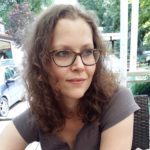Link to Pubmed [PMID] – 16885461
J. Bacteriol. 2006 Aug;188(16):5925-34
The temperate double-stranded DNA bacteriophage Bam35 infects gram-positive Bacillus thuringiensis cells. Bam35 has an icosahedral protein coat surrounding the viral membrane that encloses the linear 15-kbp DNA genome. The protein coat of Bam35 uses the same assembly principle as that of PRD1, a lytic bacteriophage infecting gram-negative hosts. In this study, we dissected the process of Bam35 entry into discrete steps: receptor binding, peptidoglycan penetration, and interaction with the plasma membrane (PM). Bam35 very rapidly adsorbs to the cell surface, and N-acetyl-muramic acid is essential for Bam35 binding. Zymogram analysis demonstrated that peptidoglycan-hydrolyzing activity is associated with the Bam35 virion. We showed that the penetration of Bam35 through the PM is a divalent-cation-dependent process, whereas adsorption and peptidoglycan digestion are not.

